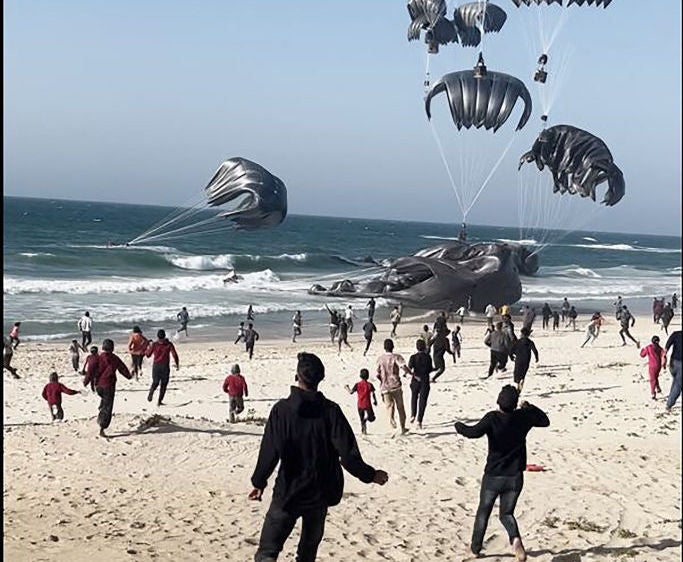A UAE C-17 and ‘high velocity’ parachutes may be behind deadly air drop in Gaza
A United Arab Emirates C-17 may have delivered an aid drop to waiting Gazans using dangerously small parachutes meant for combat.

Video and flight tracker data appears to point toward a United Arab Emirates C-17, not a U.S. plane, as the aircraft behind a wayward humanitarian aid drop in Gaza Friday that reportedly killed several civilians on the ground. Pentagon officials denied early reports that a U.S. plane was responsible for the deaths, and noted that the Air Force has not used C-17s to make drops in Gaza. U.S. officials also would not confirm deaths on the ground beneath any aid drops, but did not dispute the reports.
Though media reports have cited parachute “malfunctions” as causing injuries and deaths among the waiting crowd, the use of a high-speed parachute intended for combat in the drop may also have been a factor. Video of the drop appears to show that a C-17 used so-called “high velocity” parachutes for the ill-fated drop, which may have made the bundles fall into waiting crowds far faster and more dangerously than other drops this week that used larger, slower parachutes.
A video posted online early Friday by journalist Ismail Alghoul captures a C-17 dropping more than 20 bundles over a building and an adjacent open field under what appear to be Low Cost High Velocity, or LCHV, parachutes. An LCHV parachute is made of 12 panels that open in a narrow cone compared to the wide canopies of larger cargo parachutes. One bundle plummets unchecked onto a building while three others scream earthward nearby, open but nearly in freefall. But even the majority of parachutes that appear to work properly fall much faster than a typical cargo, personnel or aid bundle would under a traditional parachute.
No injuries are visible on the video but later reports from witnesses and Gaza officials said that five civilians died under the falling cargo.
At a Pentagon briefing Friday afternoon, Maj. Gen. Pat Ryder said the U.S. has used only C-130s to drop aid in Gaza, not C-17s and a post on X from U.S. Central Command denied involvement with the drop.
CENTCOM and the Jordanian Air Force delivered a joint C-130 drop at about 1:30 p.m. in Gaza, about 30 minutes after Aghoul uploaded the video of the drop.
Flight tracking websites suggest the drop came from a UAE C-17. Sites followed the course of a UAE C-17 that appeared to match the profile of the aid drop caught on video. That C-17 overflew Gaza around 10:30 a.m. local time. The plane slows to under 200 knots just below 3,000 feet as it passes over a strip of the Rimal neighborhood — speeds and altitudes nearly unheard of for a C-17 except during parachuting operations.

The UAE Air Force has been carrying out aid drops under an operation it calls “Birds of Goodness.”
Parachutes come in many shapes and sizes and are used by different agencies for different cargo. The Egyptian Air Force has dropped aid supplies in Gaza under distinctive square-tent-style parachutes, while Israeli forces have resupplied their troops with a wing-like “Guided Supply” system, similar to the U.S. JPADS, which can autonomously fly a steerable parachute to a specific target.
U.S. drops in Gaza have so far used parachutes known as Low Cost-Low Velocity, or LCLV parachutes, which perform similarly to the U.S. military’s G12 cargo parachute. Unlike traditional cargo and personnel parachutes commonly used by U.S. paratroopers, the LCLV system is designed for single-use, such as aid drops or resupplies to isolated troops when parachutes are not expected to be recovered. The LCLV chutes are roughly square, with 20 vertical panels stitched together and perform similarly to the G12. They are designed to be dropped from low altitudes, open quickly and fall at less than 28 feet per second, or less than 20 miles per hour.
For comparison, U.S. paratroopers like those in the 82nd Airborne jump from planes under T-11 parachutes, which are designed to drop a soldier carrying a full combat load of equipment at 19 feet per second, or just 13 MPH.
LCLV’s were used by U.S. C-130s in the aid drops on March 2 near a Gaza beach, where some of them can be seen floating onto land. U.S. planes have used them in each drop in Gaza, according to pictures released by the Pentagon.
But the parachutes used by the UAE C-17 appear to be LCHVs, a combat parachute meant for higher risk drops when no civilians are expected to be beneath them. The LCHV has just three panels per side and fall far faster that the LCLV. According to the manufacturer, LCHVs are designed to be dropped from above 3,000 feet — higher than the Emirate C-17 was flying when it released the load — and fall between 60 and 90 feet per second, or as fast as 60 mph.

High-velocity parachutes are commonly used to drop equipment, particularly in high-risk combat missions. According to a 2011 research paper on parachute accuracy for the Air Force Institute of Technology by then-Capt. Vincent Cammarano, “high-velocity airdrops for rugged cargo minimize the effects of winds on airdrop trajectory and maintain accuracy while allowing for higher release altitudes and increase aircraft survivability.”
United Arab Emirates crews have used high-velocity parachutes before, including in a drop which the Pentagon said was the UAE Air Force’s first-ever cargo drop. In 2019, a UAE C-17 crew participating in Mobility Guardian 2019 in the U.S. was captured by an Air Force film crew dropping a training load nearly identical to the Gaza drop, including with high velocity parachutes.

The latest on Task & Purpose
- Sailors at Norfolk will be locked out of their rooms if they fail inspection
- Army Reserve colonel allegedly pocketed $62,000 in fake rental property scheme
- Army quietly dropped 5-mile run requirement from airborne school in 2018
- Alaska paratroopers get a secret weapon for the arctic: beards
- Army will add 17 air defense units while cutting 24,000 active duty spots
